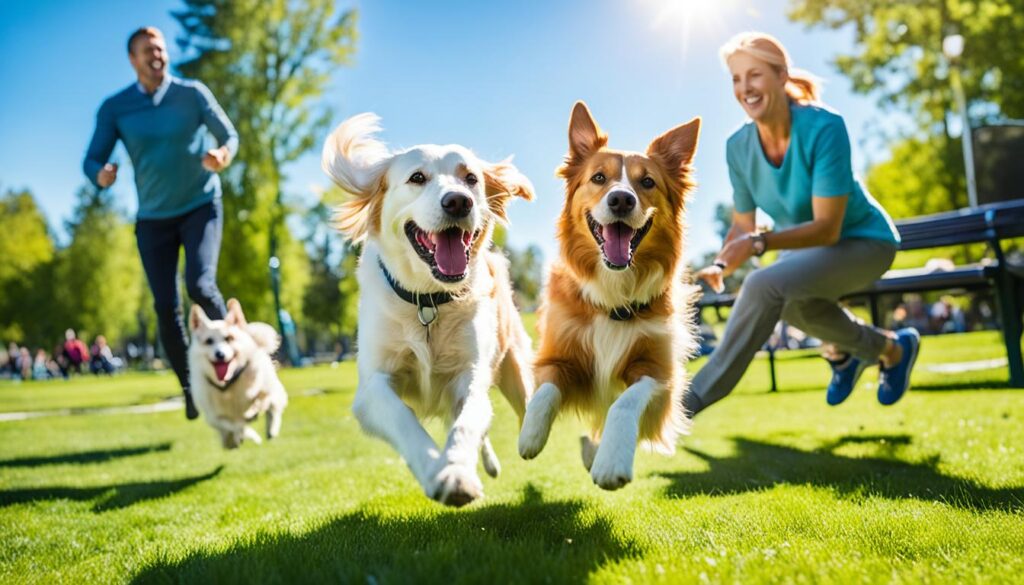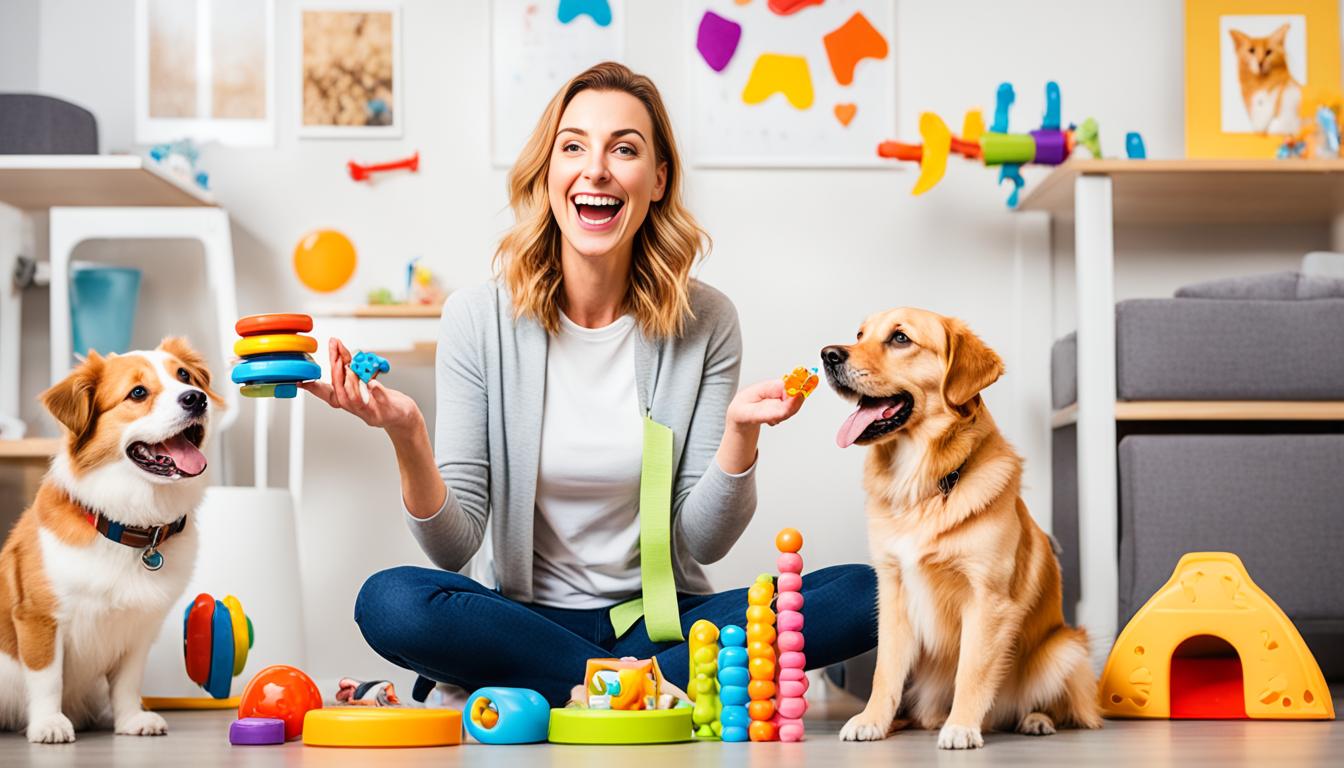Greetings pet owners! Are you ready to embark on a transformative journey with your furry friend? Training your pet for success goes beyond teaching basic commands. It’s about building a strong bond, understanding their behavior and personality, and using effective techniques to encourage good behavior while addressing any challenges that may arise.
In this comprehensive guide, I will share with you the key elements of successful pet training. From establishing trust and communication to mastering basic commands and incorporating positive reinforcement, we will cover it all. Whether you have a dog or a cat, this guide is designed to help you become a successful pet owner and have a well-behaved and happy companion by your side.
Key Takeaways:
- Training your pet for success involves building a strong bond and understanding their behavior.
- Effective training techniques include establishing trust, consistent communication, and positive reinforcement.
- Mastering basic commands is essential for everyday manners and ensuring your pet’s safety.
- Positive reinforcement through rewards and redirecting negative behavior promotes good habits.
- Advanced training techniques and pet socialization enhance mental stimulation and create a friendly companion.
Understanding Your Pet’s Behavior and Personality
Before diving into training techniques, it’s essential to understand your pet’s behavior and personality. Each pet is unique, and their behavior is influenced by factors such as breed, temperament, and past experiences. By gaining insight into why your pet behaves the way they do, you can tailor your training approach to their specific needs. This section will provide valuable tips and insights into understanding your pet’s behavior and how it influences their training.
Understanding your pet’s behavior is key to effective training. By studying their actions and reactions, you can decipher their motivations and identify any behavior challenges that may arise. This knowledge enables you to address these challenges with appropriate behavior modification techniques and training methods.
One aspect of understanding your pet’s behavior is recognizing and interpreting their body language. Dogs, for example, use various physical cues to convey their emotions, such as wagging tails, raised hackles, and ear positions. By being attentive to these signals, you can better gauge their mood and respond accordingly.
Another important consideration is your pet’s personality. Just like humans, pets have unique personalities that shape their behavior. Some pets may be more outgoing and eager to please, while others may be more independent or cautious. By understanding your pet’s personality traits, you can tailor your training techniques to cater to their specific needs and motivations.
“Understanding your pet’s behavior is the foundation for successful training. It allows you to adapt your approach and create an environment that encourages learning and cooperation.”
By investing time and effort in understanding your pet’s behavior and personality, you can establish a strong foundation for successful training. This understanding will enable you to tailor your training techniques and address challenges in a way that promotes positive behavior modification and a well-behaved pet.
| Benefits of Understanding Your Pet’s Behavior and Personality |
|---|
| Improved communication between you and your pet |
| Effective identification and management of behavior challenges |
| Customization of training techniques based on your pet’s needs |
| Creation of a positive and cooperative training environment |
Training Your Pet for Success: The Bonding Process
Building a strong bond with your pet is the foundation for successful training. By establishing trust, respecting their comfort zone, and developing a clear mode of communication, you create a harmonious environment that promotes learning and cooperation. In this section, I will delve into the importance of consistent training, recognizing and respecting your pet’s boundaries, and fostering open lines of communication that will last a lifetime.
Establishing Trust through Consistent Training
Trust is the cornerstone of any successful pet-owner relationship. Consistent training plays a vital role in building trust with your pet. By setting clear expectations and consistently reinforcing desired behaviors, you establish a sense of security and predictability for your pet. This helps them feel confident, knowing what is expected of them and how they can earn your praise and rewards.
Recognizing and Respecting Your Pet’s Comfort Zone
Every pet has their own unique comfort zone, and respecting it is essential during training. Pushing your pet beyond their comfort zone too quickly can lead to anxiety and resistance. Take the time to understand your pet’s boundaries and gradually introduce new experiences and challenges at a pace that’s comfortable for them. By doing so, you create a nurturing environment where your pet feels safe, allowing them to learn and grow in a positive way.
Building a Lifetime of Communication
Effective communication is key to training success. It involves more than just giving commands. It requires understanding your pet’s body language, vocal cues, and individual personality traits. Pay attention to how your pet responds to different training methods and adjust your approach accordingly. By establishing clear, consistent communication, you’ll be able to convey your expectations to your pet and understand their needs and desires. This deepens the bond between you and allows for an even stronger connection built on trust and understanding.
Mastering Basic Commands for Everyday Manners
Mastering basic commands is essential for ensuring your pet’s safety and promoting good behavior in various situations. By teaching your pet commands like sit, stay, come, and heel, you can establish a foundation of obedience that will make everyday interactions with your pet more enjoyable and manageable.
To teach your pet these fundamental commands, follow these step-by-step instructions:
- Sit: Start by holding a treat close to your pet’s nose, then move your hand upwards, causing their head to follow the treat and their bottom to lower. Once they are in a sitting position, say “sit” and give them the treat as a reward. Repeat this process multiple times until your pet understands the command.
- Stay: Begin by telling your pet to sit. Once they are sitting, extend your hand in front of their face, saying “stay.” Take a step backward and wait a few seconds. If your pet remains seated, return to them and give them a treat as a reward. Gradually increase the distance and duration of the stay command over time.
- Come: Start by putting a leash on your pet and getting down to their level. Say “come” in a friendly and inviting tone, then gently tug the leash towards you. When your pet begins to move towards you, continue to praise and encourage them. Reward their successful response with a treat and positive reinforcement.
- Heel: Begin by attaching a leash and standing by your pet’s side. Start walking, and if your pet begins to pull or move ahead, use a gentle pull on the leash and say “heel.” When they move back to your side, reward them with a treat and positive reinforcement. Practice walking on a loose leash, rewarding them for staying by your side.
Consistency, patience, and positive reinforcement are key when teaching your pet basic commands. Make training sessions short, frequent, and enjoyable to keep your pet engaged and motivated. Remember to always reward good behavior and avoid punishment or negative reinforcement.

Remember, every pet is unique, so be patient and adapt your training approach to their individual needs. With dedication and practice, your pet will master these basic commands, paving the way for a well-mannered companion.
| Command | Description |
|---|---|
| Sit | Teaches your pet to sit on command, promoting calm behavior. |
| Stay | Encourages your pet to remain in one place until released. |
| Come | Teaches your pet to come to you when called, improving recall. |
| Heel | Teaches your pet to walk calmly by your side on a loose leash. |
Positive Reinforcement: Encouraging Good Behavior
Positive reinforcement is a highly effective training technique that involves rewarding your pet for good behavior. By using treats, toys, and praise, you create a positive association with desirable actions, making your pet more motivated to repeat them.
The power of rewards cannot be underestimated when it comes to pet training. Treats, in particular, can be a powerful tool in reinforcing good behavior. They are a tangible and immediate reward that can quickly communicate to your pet that they are doing something right. Whether it’s a small treat for sitting on command or a larger reward for mastering a new trick, treats can help solidify the connection between the desired behavior and the positive outcome.
However, it’s important to use treats judiciously to avoid overfeeding and to maintain a healthy weight for your pet. Choose high-quality treats that are specifically designed for training purposes, as they are often smaller in size and have a strong aroma that appeals to your pet’s senses.
Timing and delivery are critical aspects of positive reinforcement. The reward should be given immediately after your pet exhibits the desired behavior so that they can make a clear connection between the action and the reward. This helps reinforce the behavior and encourages your pet to repeat it again in the future.
In addition to treats, you can also use toys and praise as rewards for good behavior. Toys can provide mental and physical stimulation while serving as an alternative reward for certain behaviors. Praise, on the other hand, can go a long way in reinforcing your pet’s self-esteem and sense of accomplishment. A simple, enthusiastic “Good boy!” or “Well done!” can make a world of difference in motivating your pet to continue exhibiting good behavior.
Redirecting negative behavior is another important aspect of positive reinforcement training. Instead of punishing your pet for undesirable behavior, focus on redirecting their attention to something more appropriate. For example, if your pet is chewing on furniture, provide them with a chew toy as an alternative. This helps teach your pet what is expected of them while preventing frustration and confusion.
By using positive reinforcement, rewarding good behavior, and redirecting negative behavior in a constructive way, you can create a harmonious training environment that encourages your pet to grow and thrive.
Leash Training and Safe Walks
Leash training plays a crucial role in ensuring the safety and enjoyment of your pet during walks. By teaching your pet leash manners and loose leash walking techniques, you can make your outdoor adventures more pleasant and stress-free. Here are some practical tips to help you with leash training and ensure safe and enjoyable walks with your pet:
- Choose the right leash: Use a leash that is appropriate for your pet’s size and strength. Make sure it is in good condition and securely attached to your pet’s collar or harness.
- Start indoors: Begin by introducing your pet to the concept of walking on a leash in a familiar and controlled environment, such as your home or backyard.
- Use positive reinforcement: Reward your pet with treats and praise when they exhibit desired leash manners, such as walking calmly beside you. This will reinforce positive behavior and make the training experience more enjoyable for your pet.
- Be patient and consistent: Leash training takes time and consistency. Use regular, short training sessions to gradually increase your pet’s comfort and understanding of walking on a leash.
- Practice loose leash walking: Teach your pet to walk with a relaxed leash, avoiding tense pulling or dragging. Encourage them to walk by your side and reward them for maintaining a loose leash.
- Teach basic commands: Incorporate basic commands like “sit,” “stay,” and “heel” into your leash training sessions. These commands will help you maintain control and ensure your pet’s safety during walks.
- Provide mental and physical stimulation: Engage your pet in activities that stimulate their mind and body before walks. This can help reduce excess energy and improve their focus during training.
- Be aware of your surroundings: Pay attention to your surroundings and take necessary precautions to ensure the safety of your pet. Avoid busy roads, off-leash dog parks, or any potential hazards that might cause harm.
Remember, leash training is a process that requires patience, consistency, and positive reinforcement. By following these tips and techniques, you can help your pet become a well-behaved and confident walker, allowing you both to enjoy safe and pleasant walks together.

Advanced Training Techniques for Mental Stimulation
Once your pet has mastered the basics, it’s time to take their training to the next level. Advanced training techniques not only provide mental stimulation but also contribute to further strengthening the bond between you and your pet. These activities go beyond simple commands and offer exciting challenges that engage your pet’s cognitive abilities and problem-solving skills.
Agility Training: A Fun Challenge for Your Pet
If your pet loves to run, jump, and navigate obstacles, agility training can be a great way to keep them mentally and physically active. Agility courses typically include hurdles, tunnels, weaving poles, and other fun obstacles that your pet can learn to navigate with speed and precision. This activity promotes coordination, focus, and confidence in your pet while providing an outlet for their energy.
Teaching Tricks for Cognitive Development
Teaching tricks to your pet is an excellent way to provide mental stimulation and challenge their cognitive abilities. From simple tricks like shaking hands and rolling over to more complex ones like playing dead or fetching specific objects, trick training encourages problem-solving and enhances your pet’s ability to learn and adapt. Remember to use positive reinforcement and plenty of rewards to make the learning process enjoyable for your pet.
Interactive Play to Enhance Problem-Solving Skills
Engaging your pet in interactive play sessions can help sharpen their problem-solving skills while providing mental stimulation. Puzzle toys, treat-dispensing toys, and interactive games that require your pet to figure out how to access rewards can keep them entertained and mentally challenged. These activities also promote focus, patience, and persistence in your pet’s behavior.
| Activity | Description | Benefits |
|---|---|---|
| Agility Training | Teach your pet to navigate obstacle courses with speed and precision. | Promotes coordination, focus, and confidence |
| Teaching Tricks | Train your pet to perform various tricks that challenge their cognitive abilities. | Enhances problem-solving skills and adaptability |
| Interactive Play | Engage your pet in play sessions with puzzle toys and treat-dispensing toys. | Sharpens problem-solving skills and promotes focus |
By incorporating these advanced training techniques into your pet’s routine, you can provide them with mental stimulation, promote growth and learning, and strengthen the bond between you and your beloved companion.
Pet Socialization: Creating a Friendly Companion
Socialization is crucial for pets to develop into friendly and well-adjusted companions. By introducing them to new environments, people, and other animals in a positive and controlled manner, you can help them build confidence and form positive associations.
Creating a friendly pet starts with exposing them to a variety of experiences early on. This includes taking them to new places such as parks, pet-friendly cafes, or even pet stores. These outings provide opportunities for your pet to interact with different sights, sounds, and smells, allowing them to become more comfortable and adaptable in unfamiliar situations.
When introducing your pet to new people, it’s important to facilitate positive interactions. Encourage gentle and calm behavior, rewarding them with praise or treats when they approach new individuals in a friendly manner. This helps to reinforce pet-friendly behavior and builds their confidence in social situations.
Additionally, gradually introducing your pet to other animals can promote healthy socialization. Start with controlled interactions, such as playdates with calm and friendly pets. Observe their interactions closely, providing guidance and redirection if necessary. Over time, they will learn appropriate social cues and develop positive relationships with other animals.

Remember, each pet is unique, and their comfort levels may vary. Respect their boundaries and never force interactions if they seem fearful or uncomfortable. Patience and positive reinforcement are key to helping your pet feel safe and secure in new environments and with new experiences.
By prioritizing pet socialization and creating a friendly environment, you will not only have a well-behaved companion but also a pet that is confident, adaptable, and able to thrive in various social settings.
| Benefits of Pet Socialization | Importance of Introducing Pets to New Environments | Effective Strategies for Pet Socialization |
|---|---|---|
| 1. Enhanced sociability | 1. Exposure to different sights, sounds, and smells | 1. Gradual introductions and controlled interactions |
| 2. Reduced anxiety and fear | 2. Building confidence and adaptability | 2. Positive reinforcement for friendly behavior |
| 3. Improved obedience and responsiveness | 3. Developing trust in new environments | 3. Patience and respect for your pet’s comfort zone |
| 4. Prevention of aggressive behavior | 4. Encouraging positive associations | 4. Seeking professional guidance if needed |
Dealing with Common Behavior Challenges
Addressing common behavior challenges is an important aspect of successful pet training. This section will focus on specific behavior challenges such as excessive barking, separation anxiety, and destructive behaviors. It will provide practical strategies and techniques to help you understand and effectively address these challenges, promoting a harmonious and well-behaved pet.
Excessive Barking and How to Curb It
Excessive barking can be a frustrating behavior problem for many pet owners. Whether triggered by boredom, fear, or territorial instincts, excessive barking can disrupt your household and cause unnecessary stress. To curb this behavior, it is crucial to understand the root cause and address it accordingly.
One effective strategy is to provide mental and physical stimulation for your pet. Engage them in interactive play, such as puzzle toys or regular exercise, to alleviate boredom and reduce the urge to bark excessively. Additionally, you can use positive reinforcement techniques to reward quiet behavior and redirect their attention to more appropriate activities.
It is important to remain patient and consistent throughout the training process. Seek professional guidance and consult with a veterinarian or animal behaviorist if the problem persists.
Managing Separation Anxiety in Pets
Separation anxiety is a common challenge faced by many pet owners when leaving their pets home alone. Pets with separation anxiety may exhibit destructive behavior, excessive vocalization, or even attempt to escape. To manage separation anxiety, it is essential to create a safe and comforting environment for your pet.
Start by gradually desensitizing your pet to your departures. Practice leaving for short periods, gradually increasing the duration over time. Provide them with engaging and interactive toys, such as food puzzles, to keep them occupied while you are away. Additionally, consider creating a designated safe space for your pet, such as a crate or a separate room, where they can feel secure and protected.
Seeking professional help from a qualified animal behaviorist can also be beneficial in managing separation anxiety in pets.
Strategies to Reduce Destructive Behaviors
Destructive behaviors, such as chewing furniture or digging holes in the yard, can be frustrating for pet owners. These behaviors are often a result of boredom, lack of exercise, or anxiety. To reduce destructive behaviors, it is important to provide appropriate outlets for your pet’s energy and address any underlying issues.
Ensure that your pet receives sufficient physical and mental stimulation through regular exercise and interactive play. Provide them with a variety of toys and activities that stimulate their natural instincts. Consider using deterrents, such as bitter sprays or motion-activated devices, to discourage destructive behaviors in certain areas.
Consistency and positive reinforcement are key in redirecting your pet’s behavior. Reward them for engaging in appropriate activities and redirect their attention when they display destructive behaviors. Additionally, providing a safe and designated space for your pet to explore and engage in their natural behaviors can effectively reduce destructive tendencies.

By implementing these strategies and techniques, you can effectively address common behavior challenges and promote a harmonious and well-behaved pet.
Conclusion
As we conclude this comprehensive pet training guide, it’s time to reflect on the rewards of diligent training and the journey of growth you and your pet have embarked on together.
Reaping the Rewards of Diligent Pet Training
By investing time and effort into effective pet training, you have set the foundation for a well-behaved and happy companion. Through consistent training and positive reinforcement, you have taught your pet essential commands, encouraged good behavior, and addressed common challenges. You can now enjoy the rewards of having a pet who listens, behaves appropriately, and brings joy and companionship to your life.
The Journey of Growing Together As a Team
One of the most beautiful aspects of pet training is the journey of growing together as a team. Through training, you have built a strong bond and established trust with your pet. You have learned to understand their behavior and personality, adapting your training approach to suit their individual needs. This shared experience has deepened your connection and created a harmonious dynamic that will continue to strengthen over time.
Lasting Impact of Training on Pet-Owner Relationship
The lasting impact of training goes beyond the immediate benefits of a well-behaved pet. Training has a profound impact on the pet-owner relationship, fostering mutual respect and open lines of communication. By investing in your pet’s training, you have demonstrated your commitment to their well-being and happiness, laying the groundwork for a lifelong bond built on trust and understanding.
In conclusion, the benefits of effective pet training are immeasurable. The rewards of a well-behaved pet, the journey of growth as a team, and the lasting impact on your pet-owner relationship make the investment of time and effort well worth it. So continue to nurture your pet’s training, and enjoy the lifelong rewards of having a happy and well-behaved companion by your side.
FAQ
What factors influence my pet’s behavior?
Factors such as breed, temperament, and past experiences can influence your pet’s behavior.
How can I build a strong bond with my pet?
You can build a strong bond with your pet by establishing trust, respecting their comfort zone, and developing clear communication.
What are some basic commands I should teach my pet?
Some basic commands to teach your pet include sit, stay, come, and heel.
How does positive reinforcement training work?
Positive reinforcement training involves rewarding your pet for good behavior using treats, toys, and praise.
How can I leash train my pet?
Leash training can be done by teaching your pet to walk calmly on a leash and responding to basic commands like “heel”.
What are some advanced training techniques for my pet?
Advanced training techniques include agility training, teaching tricks for cognitive development, and interactive play.
How can I socialize my pet with others?
You can socialize your pet by introducing them to new environments, people, and other animals in a positive and controlled manner.
How can I address common behavior challenges in my pet?
Common behavior challenges can be addressed through specific strategies for excessive barking, separation anxiety, and destructive behaviors.
What are the rewards of diligent pet training?
Diligent pet training leads to a well-behaved companion and strengthens the bond between you and your pet.
How does pet training impact the pet-owner relationship?
Pet training improves the pet-owner relationship by promoting understanding, communication, and a harmonious living environment.
Source Links
- https://basepaws.com/dog-insider/top-dog-training-tips
- https://www.linkedin.com/pulse/harmony-home-effective-training-techniques-well-behaved-pet-w1h2f?trk=article-ssr-frontend-pulse_more-articles_related-content-card
- https://www.smalldoorvet.com/learning-center/behavior/top-10-dog-training-tips

